Chapter 2 Reading Comprehension
A. Format of the Exam
The reading portion of the exam is usually divided in following formats:
- Advertisement, pamphlet, promotional material, or announcement (5 questions)
- Fragment of a literary text (7 questions)
- Article accompanied by a graph, table, or chart (11 questions)
- Correspondence (7 questions)
B. Types of Questions
There are four categories to expect:
- ==Understand Content.== Identify the main idea and details.
- ==Think Critically.== Identify the purpose of the text, the target audience, point of view of its author, the tone or attitude, how the author communicates his/her ideas, and be able to separate fact from opinion, make predictions based on information presented in the text.
- ==Understand Meaning.== Infer the meaning of unfamiliar words and expressions using context clues, and comprehend a wide variety of vocabulary, idioms, and cultural expressions.
- ==Understand Culture and Content Across Disciplines.== Identify practices, products and perspectives of Hispanic cultures and information pertaining to other disciplines, such as science, geography, history, art, and so on.
C. Reading Strategies
Suggestions for Reading
You should follow these steps every time you approach a reading comprehension text.
Before Reading the Text
- ==Read The Introduction And Title==. All reading selections will have a brief introduction about the text and its source. This information is helpful to get you thinking about what information will be presented, as well as the possible point of view of the author and intended audience.
- ==Scan The Whole Passage.== Scanning will help you get a general idea of the topic. Many articles are divided into subsections, and scanning beforehand will allow you to predict what information might be presented in each section.
- ==Scan The Questions.== This will give you an idea of what information you will need to find in the passage.
- ==Use Visuals.== If the passage includes a graphic, make a note of its relation to the printed words. This will help you determine the purpose of the visual insert.
While Reading the Text
- ==Visualize As You Read==. Imagine in your mind’s eye what is being said. This will help you understand the ideas and tone of the text, and reduce the tendency to translate.
- ==Underline Key Words and Ideas==. This will allow you to quickly retrieve information from the text.
- ==Identify the Main Idea.== Look for repetition of words or phrases, or look for words that are topically related.
- ==Identify Setting, Action, and Main Characters.== When determining the setting, note the time frame and the place of the action. If there is any action, get a general idea of what happens. For more factual texts, such as a report, note when, where, how, and why it happened. If a character has no name, identify him or her by some other characteristic, such as color of hair, personality, or clothing.
- ==Make Note of Elements Relating to Hispanic Culture.== Remember that the examination tests both language and culture. It is important to identify and understand any products (food, clothing, art, etc.), the practices (customs and traditions), and perspectives (attitudes, values, and ideas) of Hispanic culture and be able to recognize how they differ from those of your own culture. Even if you are not asked a specific question about this information, it is useful to further develop your awareness of Hispanic culture and societies.
- ==Focus on Words you Recognize and Use Context Clues to Infer the Meaning of Unfamiliar Words.== Unknown words are often restated with other words you do know, especially if they are important to understand the passage. There are a number of strategies that can help you infer meaning from unfamiliar vocabulary, and these are discussed more in depth in the following section.
After Reading the Text
- ==Reflect on the Reading.== Think of the reading as a whole and synthesize the information presented. Take the information presented to you at face value, regardless of whether or not you agree with the information presented or with the author’s point of view.
D. Answering Reading Comprehension Questions
Understanding Content
Understanding content encompasses one’s ability to identify the main idea of a passage and the details relating to the passage.
Identify the Main Idea
To identify the main idea, you should scan the passage, including the title, and make a mental note of those words that are important and begin to think
about what they all have in common
PRÁCTICA
Read the passage and select the best answer for each question that follows.
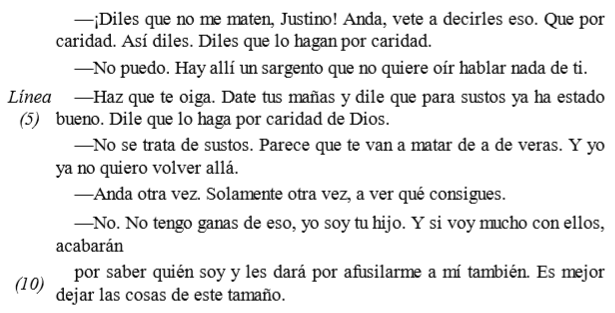 |
|---|
¿Cuál es la actitud del padre de Justino?
Resignado
Impávido
Desesperado
Asustado
Pregunta #1: c
The lines by Justino and his father alternate between commands and refusals. The father’s every line is a command for his son to go ask, tell, or beg for his life. Justino’s every line communicates his desire to not become involved. Through the repetition of the command “Diles,” the father communicates his desperation, not resignation, fear, or intrepid behavior.
¿Cómo caracterizaría el tipo de hijo que parece ser Justino?
Egoísta
Cruel
Cariñoso
Temeroso
Pregunta #2: d
Justino’s fear for his own life overwhelms any familial love that he may have felt for his father. His constant denial and proffered “reason” are not convincing; they sound like excuses, except that there is a grain of truth to the gravity of the situation as he sees it. At the end, Justino confesses that he does not want to press too much because the sergeant apparently does not realize that Justino is the man’s son, and Justino does not want the sergeant to know. Although Justino may be self-centered and cruel, his primary reaction is fear. This is indicated by the constant repetition of his denial, and after each denial, an explanation of his position in the matter.
Think Critically
The following steps will help you become a better critical reader:
- ==Read and Summarize==. Read the selection first so that you understand the content. Next, try to summarize the information you just read. The summary should be the main message or central idea of the passage.
- ==Analyze==. Look at the evidence presented, draw inferences where you can, and identify the tone.
- ==Synthesize==. Connect the information you read to your own prior knowledge about the theme and any personal experiences you may have on the topic. Remember that all readings somehow relate to one of the six overarching themes.
- ==Evaluate==. Assess the overall work. This is where you can determine the intended audience, the tone of the author, the validity of the argument, what evidence may be missing, and other predictions and assumptions that go beyond the text.
Questions About Purpose and Reason
There are two types of questions you are most likely going to see on the exam that deal with purpose and reason:
(1) one that asks about the overall purpose of the reading selection, and
(2) one that asks about the purpose, the reason, and/or the motivation of a particular event that takes place within the text.
PRÁCTICA # 1
Read the passage and answer the questions that follow.
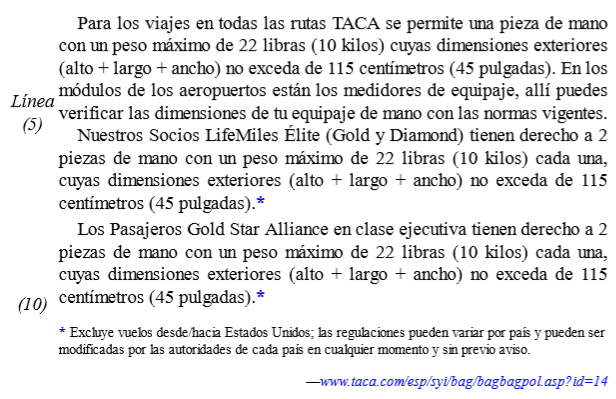 |
|---|
¿Cuál parece ser la función de este trozo?
Informarle a la gente de los diferentes tamaños de equipaje
Presentar la política de equipaje de mano de una compañía aérea
Mostrar los beneficios de ser socio de un club
Explicar las diferencias en regulaciones por distintos países
Pregunta #1: b
This piece informs the general public about what type of carry-on luggage is permissible. It only presents one size— the maximum weight and dimensions allowed, thus eliminating (a). Choice (d) really has nothing to do with the selection, and, although the passage does include information about different membership groups, it never makes an attempt to persuade someone to try to become a member, thus eliminating (c) as an option.
¿Qué función tienen los medidores de equipaje (línea 4)?
Para medir las dimensiones de las piezas de equipaje
Para averiguar cuánto puede caber en las maletas
Para encontrar el peso del equipaje
Para asegurar que sea una pieza de mano reglamentaria
Pregunta #2: d
Be careful not to be tricked by the repetition of a form of the word medir in the question and in the first option. The medidor does not measure luggage, nor does it weigh the bag. It is used to verify that the piece of luggage is small enough to be considered a carry-on according to the established reglamento, or regulations.
PRÁCTICA # 2
Read the passage and answer the questions that follow.
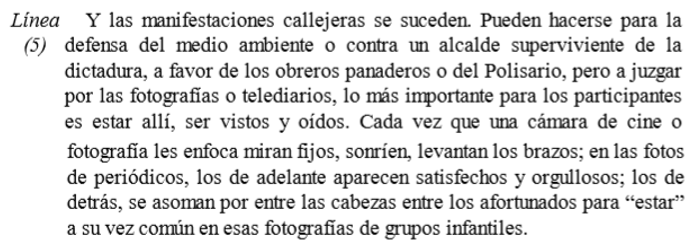 |
|---|
Según el autor, ¿por qué participa la gente en las manifestaciones callejeras?
Para ser vista y reconocida
Para celebrar sus nuevas libertades
Protesta la censura del gobierno
Quiere efectuar algún cambio social
Pregunta #1: a
Don’t be tricked by the reason the protests take place. The question asks you why the people choose to participate. According to the text, the author believes the people solely want to be seen and heard. No indication is given as to whether they actually support the protest itself.
¿Cómo reaccionan esas personas al ver una cámara?
Tratan de ocultar los rostros.
Se enorgullecen de su supuesta importancia.
Tienen miedo de ser reconocidos.
Se enfadan porque sacan fotografías de ellos.
Pregunta #2: b
This answer is quite straightforward. The other three all convey a similar idea—that of not wanting to be seen.
Determining Tone and Attitude
This tone or attitude, at times, can indicate what type of writing the passage presents.
PRÁCTICA # 1
Read the passage and answer the question that follows.
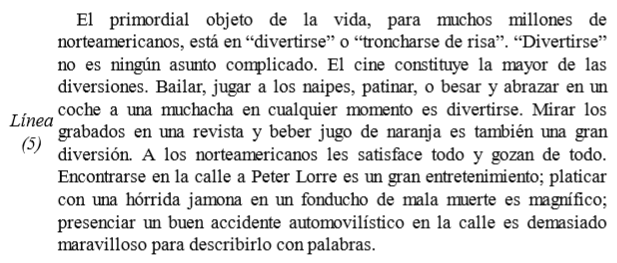 |
|---|
Ante el espectáculo de los norteamericanos tratando de divertirse en todo momento, ¿cuál de las siguientes emociones muestra el tono del narrador?
Aburrido
Entretenido
No afectado
Asombrado
Pregunta #1: b
The narrator shows a certain detached amusement for the phenomenon he is describing, as is shown in the words he chooses to name his topic: “El primordial objeto de la vida . . . .” Among the basic human drives, entertainment does not usually rank alongside self-preservation. The overstatement indicates that this narrator is somewhat detached. He is not commenting on what entertainment means to him, but rather on what it means to the people he is observing. He then enumerates things that he thinks North Americans find entertaining, a list that culminates with the sight of an automobile accident. Any spectacle is entertaining. Choice c is a possible answer, but not the best answer. One does not get the impression from this passage that the writer is entirely indifferent to the subject matter; if he found it entertaining enough to write about, he is not totally indifferent.
PRÁCTICA # 2
Read the passage and select the best answer to the question that follows.
 |
|---|
¿Cuál es la idea principal de esta selección?
Lo bueno de broncearse durante el verano
Los efectos que el sol pueden tener a la piel
La importancia de seleccionar bien una crema protectora
Lo que hay que hacer en caso de que uno reciba una quemadura
Pregunta #1: c
This selection informs the reader about the importance of protecting oneself from the sun. The main recommendation is to select a good sunblock. It highlights that protection is more important than aesthetics. The words that have a common connection that support the main idea are “cubiertas,” “bronceador,” “seguridad total,” and “protegernos.”
Understand Details
These details can relate to setting or origin (where), time (when), character, definition, or identification (who or what), purpose and reason (why), or manner (how).
PRÁCTICA # 1
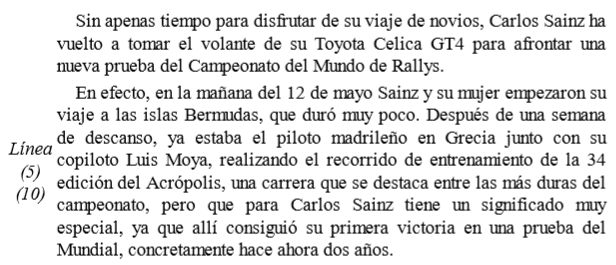 |
|---|
¿Quién dirigirá el equipo en la competencia?
La señora Sainz
Luis Moya
Carlos Sainz
Un entrenador griego
Pregunta #1: c
Carlos, as the subject of the phrase “ha vuelto a tomar el volante,” is identified as the driver, or “piloto,” about which the passage speaks. Luis Moya and la señora Sainz are secondary figures, and there is no Greek trainer.
¿Qué tipo de competencia es?
Una carrera de caballos
Una carrera aérea
Una carrera de coches deportivos
Un partido de campeonato de la Copa Mundial
Pregunta #2: c
Toyota Celica GT4 and Rally both refer to car racing, to which Sainz has returned. Choices (a), (b), and (d) are based on distracting factors. “Piloto” is the subject of the verb in “estaba el piloto madrileño en Grecia,” but nowhere in the passage is any association made with anything other than cars. The word “Mundial ” is also a distractor in choice (d), since there is a possible confusion with the World Cup in soccer competition. However, the word Copa never appears, nor are there any references to soccer.
¿Por qué estuvo Carlos Sainz en las islas Bermudas?
Para celebrar su primera victoria
Es donde decidió pasar su luna de miel
Para entrenarse para la próxima competencia
Para recuperarse mental y físicamente
Pregunta #3: b
This is a classic example of rephrasing of words or a series of words in the text. “Luna de miel” and “viaje de novios” are synonyms, and they both mean “honeymoon.”
Determining the Intended Reader
Most often the intended reader of a passage can be determined by the content of the reading itself. The intended reader is anyone who is interested enough to pick up the literature to read it.
PRÁCTICA # 1
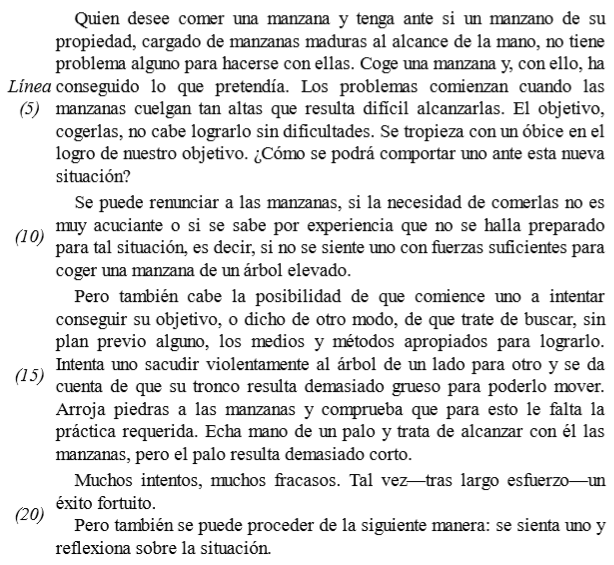 |
|---|
¿A quién parece estar dirigido este pasaje?
A un campesino hambriento
A un chico pequeño
A una persona perezosa
A una persona pragmática
Pregunta #1: d
Because the purpose of this passage is to interest the reader in learning how to solve everyday problems. This writer appeals to the reader’s reason by presenting a concrete example of a problem and then offering a variety of solutions, none of which is the most efficient manner of solving the problem. This writer is addressing a reader who wants to learn how to think logically when confronted by problems and not act impulsively. A pragmatic person is one who will analyze the situation and then take the most appropriate action, which in this case is to sit and contemplate the situation.
Making Predictions
Making predictions is a skill that should be applied throughout the reading process. You can make predictions about the content of a reading selection simply by reading its title.
PRÁCTICA # 1
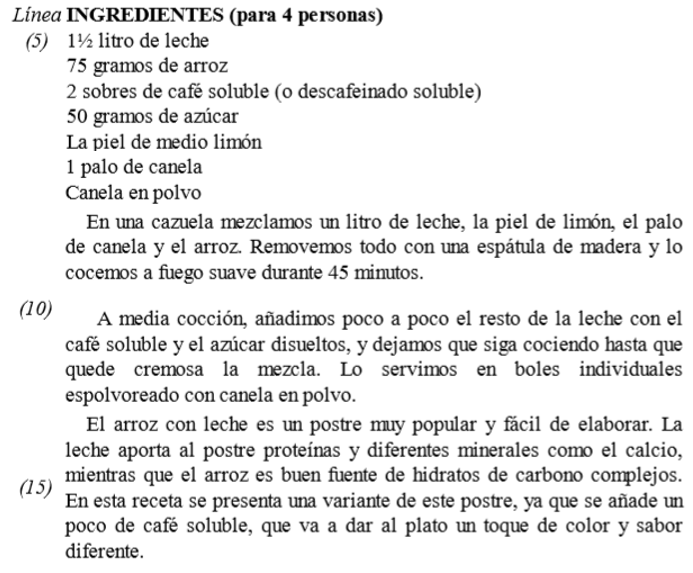 |
|---|
Si quisieras investigar más información a base del tema de esta lectura, ¿cuál de las siguientes publicaciones te sería más útil?
Postres típicos del mundo hispano
Recetas sencillas, deliciosas y saludables
Sea el perfecto anfitrión
Por qué estudiar gastronomía
Pregunta #1: a
The text obviously refers to cooking, and the reader should be able to identify that the dish being described is some sort of dessert. Not only does the word postre appear in the reading itself, but so do many ingredients associated with desserts (azúcar, piel de limón, canela). The theme of this particular reading is a dessert, making A the best answer. Both (b) and (d) deal with cooking, but you can eliminate (b) because of saludable, as most of the ingredients in this dish would not make it necessarily healthy, and choice (d) refers more to a study program, to which this text does not refer. Choice (c) is easily eliminated because it deals more with hosting a party or event but does not necessarily have anything to do with cooking.